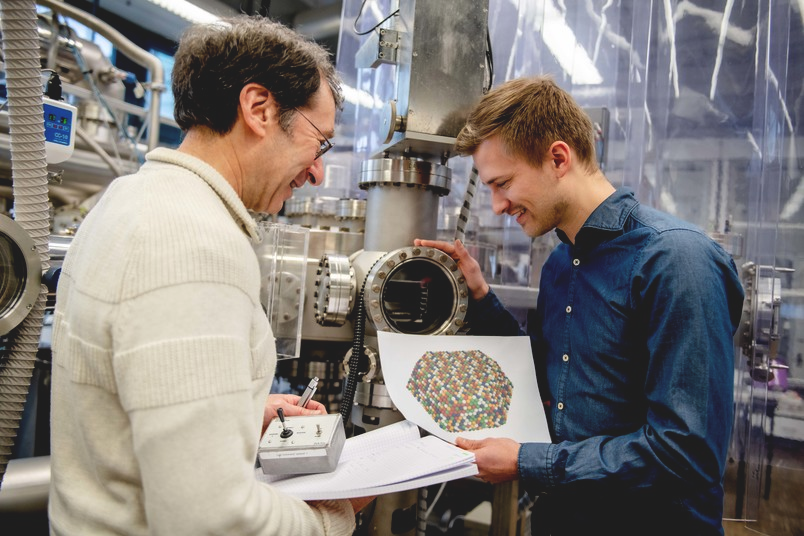Feb 5 2020
Efficient electrocatalysts largely decide the success of the energy transition, for example, in the reduction of CO2 and in fuel cells.
 Alan Savan (left) and Tobias Löffler analyze high entropy alloys. Image Credit: © RUB, Marquard.
Alan Savan (left) and Tobias Löffler analyze high entropy alloys. Image Credit: © RUB, Marquard.
Unique alloys produced from five or more elements have been identified as potential candidates. Now, a research team from Ruhr-Universität Bochum (RUB) has proposed a new concept to quickly screen a large number of potential element combinations and to identify combinations that are worth improving.
The approach helps directly establish the possibility of a promising alloy. The researchers reported the study results in the journal Angewandte Chemie International Edition on December 22nd, 2019.
Efficient Catalysts Made from Inexpensive and Available Elements
The scientists’ hopes, with respect to novel catalysts produced from available and low-cost elements, depend on the so-called complex solid solutions, also known as high-entropy alloys. These alloys contain five or more elements that are uniformly combined together, and their complex and diverse interactions make it possible to further optimize the applicable properties.
Most significantly, aside from the properties of the individual elements, the interaction of these elements is also equally important.
This opens up a wide range of otherwise unachievable possibilities in order to simultaneously optimise price and performance for possible applications.
Wolfgang Schuhmann, Professor, Center for Electrochemical Sciences, Ruhr-Universität Bochum
But the basic understanding of a newly identified group of catalysts is still lacking. What kind of data can be given by measurements to make targeted advancements in the development of catalysts? How would this help in identifying the right catalyst among the almost unlimited potential combinations? How are the properties affected by the replacement of an element and to what extent?
Interpreting Results More Accurately
We have developed a concept that enables us to understand the correlations between the selection of the elements, theoretical, activity-defining properties, and actually measurable parameters.
Tobias Löffler, Doctoral Candidate, Center for Electrochemical Sciences, Ruhr-Universität Bochum
Because the complex solid solutions are different from traditional electrocatalysts in all these respects, this knowledge is important for experimental advancement.
Therefore, the challenge faced by scientists is that in addition to the combination of elements, the amount of each element is also important and any deviations can alter the properties of the compound.
“We show how experiments with an alloy made from, for instance, five equal parts of each element can be interpreted in order to identify the element combination as potentially active,” added Tobias Löffler.
Thus, the scientists are able to find quickly whether it is indeed worthwhile to improve the amounts of the elements.
“This enables us to reduce the screening workload for possible material compositions to a fraction without overlooking promising candidates,” explained Wolfgang Schuhmann.
Without this understanding, traditional evaluations could be used to filter the combinations of elements, although these combinations could be highly fascinating if the element ratios were improved.
“What’s more, this concept forms a cornerstone in understanding the complex mode of action of this material class, which helps to better understand the possible parameters that can be adjusted and thus derive promising design concepts from this,” added Wolfgang Schuhmann.
Encouraging Researchers
The scientists tested these theoretical considerations with certain alloys using the oxygen reduction reaction applicable to fuel cells. They successfully demonstrated the kind of situations where adding or replacing an element to a current combination of elements has a positive impact and the other way around. The scientists were also able to detect the combinations of elements that are appropriate for more optimization.
For material synthesis, this means an immense saving in time and money. Producing and analysing all of the possible element ratios of an alloy consisting of five elements is a huge challenge. By eliminating elementary hurdles, we hope to further facilitate access to this highly topical and technological relevant field and encourage more researchers to contribute with their respective skills.
Alfred Ludwig, Professor, Chair for Materials Discovery and Interfaces, Ruhr-Universität Bochum
The study was financially supported by the German Federal Ministry of Education and Research in the project Nemezu (03SF0497B) and the German Research Foundation in the cluster of excellence Ruhr Explores Solvation Resolv EXC 2033—project number 390677874 and the projects LU1175/23-1, LU1175/22-1, and LU1175/26-1.
The research was also supported by the Fund from the Chemicals Industry and the Max Planck Research School for Interface Controlled Materials for Energy Conversion IMPRS Surmat.